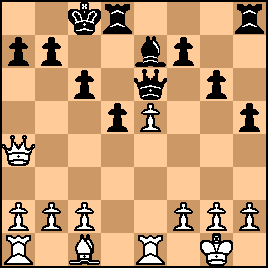| KEG: An unimpressive win by Albin over last-place finisher Mortimer. Albin did unleash a pretty combination on move 44, but even after that seemingly decisive move he needlessly put victory in jeopardy as late as his 49th move. Mortimer played reasonably sound chess until his blunder on move 29 which left himself open to a crushing attack on his King. Albin missed several chances thereafter to close out the game, but--not to worry--Mortimer let him off the hook every time and walked into a mating net. An entirely forgettable game.
1. e4 e5
2. Nf3 Nc6
3. Bb5 Nf6
The Berlin Defense had not yet gone out of fashion in 1902 (before its resurrection thanks in large measure to Vladimir Kramnik). 4. d4
4. 0-0 is most usual, though the text is sound though giving Black a fairly easy route to equality. 4... exd4
The most frequent response to 4. d4, though 4...Nxd4 is simplest. 5. e5
The sharpest line. 5. 0-0 is most usual and, like the text, leads to approximate equality. 5... Ne4
6. 0-0 Be7
6...a6 may be best, but the text is the most popular line here and was favored by--among others--Andersen, Paulson, Rosenthal, Winawer, and Showalter. It was played by Lasker in his 1907 World Championship match against Marshall. 7. Re1 Nc5
8. Nxd4 NxN
9. QxN Ne6
9...0-0 is usual and best
10. Qe4 c6
11. Bd3 d5

click for larger viewWhite is certainly better here, but Albin ruined all that with his next move: 12. Qe2?
With the obvious 12. exd6 e.p., White would have a clear edge. Not so after the text. 12... Nc5
13. Nc3
Another inferior choice by Albin. 13. c3, 13. Be3, 13, Nd2 and 13. b3 were all decent options. 13... NxB
Getting the two Bishops was tempting, but 13...0-0 or 13...a5 were even better. 14. QxN
14. cxN looks more logical, allowing for an eventual d4 to support the White pawn on e5. 14... Be6
Inferior to 14...0-0. 14...Qd7 (en route to f5) was also an interesting possibility. 15. Qg3
This plan by Albin led Mortimer to castle Queen-side. Nothing wrong with any of that, but it helped define the later course of the game, with White shifting his attack to the other wing. 15... g6
16. Ne2 h5
Mortimer now decided to launch a King-side attack. This never really got off the ground in this game. Worse still, it later distracted Mortimer from the need to defend his Queen-side. 17. Nd4 Qd7
A reasonable move, but it suggests Mortimer was ambivalent about his King-side attack since he did not follow up his 16th move with 17...h4. 18. NxB QxN

click for larger view19. Qg3
Shifting his focus to the Queen's side. But 19. Qc3 or 19. Qd3 were better if that was his idea. Albin could also have tried 19. Bg5 if he were satisfied with a draw. Given that Mortimer was by far the weakest player in the draw, it is not surprising that Albin was playing for a win. The text invited 0-0-0, and Mortimer obliged Albin: 19... 0-0-0
20. Qa4

click for larger viewThe themes of the game were becoming clearly defined. Albin would try to attack on the Queen-side, and Mortimer on the other wing. But from here play became--to put it mildly--spotty. Lots of interesting but often deeply flawed ideas. | 




